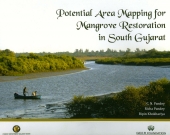Grants :: Small Grant Facilities :: Floristic diversity and natural recruitment of mangrove species in selected mangrove habitats of South Gujarat
Floristic diversity and natural recruitment of mangrove species in selected mangrove habitats of South Gujarat

Research Team at Khambat, Gujarat, India © GEER, 2007
Objectives
This Gujarat Ecological Education and Research (GEER) Foundation project set out to assess the floristic diversity, species richness and recruitment rates of mangrove forests in coastal South Gujarat. It also aimed to examine forest substrata to identify the conditions most favoured by mangroves for their natural regeneration, and to assess local people’s dependence on mangroves through a social survey.
Background
Gujarat’s 1,650-km coastline boasts the largest area of mangroves on India’s western coast (936 km², or 22% of the country’s total mangrove area). Yet the status of mangrove habitats in southern Gujarat has never been comprehensively surveyed. Though the region’s mangroves are some of the most fragmented in India, they are also thought to have the highest potential for successful reforestation.
For these reasons, GEER, with support from MFF, undertook a study with three teams working on: 1. A physical survey and mapping of mangroves; 2. A survey of floristic diversity; and 3. A socio-economic survey using a rigorous sampling and research design.
Target beneficiaries
Policy makers and local communities.
Outputs
- A comprehensive survey and mapping of mangroves in South Gujarat.
- An assessment of mangrove species richness and diversity in different habitats.
- The rediscovery of two mangrove species believed extinct in Gujarat (Bruguiera cylindrica and Bruguiera gymnorrhiza), and the discovery of large populations of the rare mangrove species Sonneratia apetala and Avicennia officinalis.
- The identification of two new mangrove biodiversity hotspots (the Purna and Ambika estuaries).
- An assessment of the status of natural mangrove recruitment in different areas.
- The identification of different substrata types preferred by various mangrove species for their regeneration.
- A survey of the dependence of local people on mangroves.
- A documentary film in English and Gujarati on the mangroves of South Gujarat.
Accomplishments and challenges
The project covered areas that had never been surveyed before, producing important new findings for long-term mangrove conservation and management.
Two species were returned to Gujarat’s existing species list and need to be included in state plantation plans. To this end, the project worked to raise awareness among forest officers, leading to a decision by the Gujarat Forest Department to launch planting and reintroduction programmes with the rediscovered species.
New areas for mangrove regeneration were identified in Navsari and Valsad districts, and the project submitted proposals to the state government urging it to declare the Purna estuary a mangrove biodiversity hot spot. In a continuation of the project, the GEER Foundation is now involved in creating a GIS database and a herbarium.
Challenges
The challenge now lies in working with the Gujarat state government to ensure designation of the Purna estuary as a mangrove biodiversity hotspot.
Contributions to cross-cutting themes
Communications
The project documented the socio-economic dependence of local communities on mangrove forests, and presented its findings to the State-Level Steering Committee for the Conservation of Mangroves and Coral in May 2009. The project also produced a documentary film, The Lesser Known Mangrove Habitats of South Gujarat, launched on World Environment Day in 2009 by the Chief Minister of Gujarat.
Gender equality
Both men and women were included in the project’s socio-economic survey of local mangrove-dependent communities.
Climate change
By giving authorities the data they need to establish new mangrove plantations, the project has helped to increase coastal resilience to the more frequent extreme weather events predicted under climate change.
Lessons Learned
The importance of involving local people in survey work became rapidly apparent – fishers assisted researchers by showing them the locations of key mangrove species.
Related News
Potential Area Mapping for Mangrove Restoration in South Gujarat
Gujarat, India 13 Mar 2013
Country: India
Topic: Knowledge for Management, Strategies for Management, Capacity Building ...
Mangroves are the most important ecological bio-shields for the coasts; they protect our coastlines, harbor unique biodiversity, support fisheries and protect coastal populations against storms, cyclones and tsunamis
Project Facts
Country
Location
South Gujarat, India
Topic
- Knowledge for Management
- Capacity Building
- Coastal Governance
- Gender equality
- Climate change
- Knowledge management and communications
Duration
30th Dec 2008 to 31st Oct 2009
MFF Grant Amount
US$14,998
Implementing Partner
C. N. Pandey
Gujarat Ecological Education and
Research (GEER) Foundation,
Indroda Nature Park, PO Sector 7,
Gandhinagar 382 007, Gujarat, India
Email: dir-geer@gujarat.gov.in


